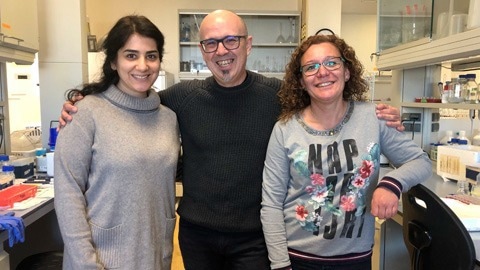Researchers at Universitat Autònoma de Barcelona (UAB) have created spherical, biocompatible, and stable nanostructures that have a strong affinity for spike proteins and guard against cell infection. The researchers’ modular and self-assembly approach would enable them to create molecules with high antiviral potential and modify them to attack new viruses.

IBB-UAB researchers who developed the OligoBinders Molood Behbahanipour (left), Salvador Ventura and Susanna Navarro. Image Credit: Universitat Autnoma de Barcelona
Due to their modularity, regulated self-assembly, and stability, amyloid protein-inspired nanomaterials are becoming more and more popular in the field of nanotechnology.
The ability to include protein molecules with the appropriate functionality via genetic engineering is a significant benefit of these materials. Since many are insoluble and unable to be delivered through bodily fluids, this makes them unsuitable for biomedical uses.
A new class of nanoparticles with the ability to neutralize the SARS-CoV2 virus has been created by researchers at the Universitat Autònoma de Barcelona (UAB). These particles were inspired by the structure of amyloids. The nanostructures, known as OligoBinders, have a strong ability to bind viral particles and are soluble, biocompatible, and stable in plasma.
This binding prevents the viral spike protein from interacting with the ACE2 receptor on the cell membrane, which causes infection.
Salvador Ventura and Susanna Navarro, scientists from the UAB’s Institute of Biotechnology and Biomedicine (IBB) and Department of Biochemistry and Molecular Biology, were the lead investigators of the study.
The researchers linked two miniproteins, LCB1 and LCB3, to a small yeast peptide known as Sup35 to take advantage of its ability to self-assemble into the nanoparticles. Three helices are used to create these mini proteins, which are extremely stable and make several interactions with the viral protein.
They were able to create two spherical nanoparticles with more than 20 copies of LCB1 or LCB3 on each of their surfaces because of their modular design strategy.
This fact gives the nanoparticles great avidity for the virus and allows them to bind simultaneously to several spike proteins.
Susanna Navarro, Associate Professor, Department of Biochemistry and Molecular Biology, Universitat Autònoma de Barcelona
The researchers note the strong inhibitory potential of these new nanoparticles and their potential as an effective substitute for the use of monoclonal antibodies for capturing or neutralizing the virus. The authors have conducted their work using particles identical to the SARS-CoV2 virus (SC2-VLP).
The developed nanospheres can be utilized in biomedicine applications, such as self-administered nasal treatments, biotechnology, the production of diagnostic kits, or as a potential prophylactic drug. Assembly would also happen naturally once the molecules have been incubated, making large-scale manufacturing simple and affordable.
The modular strategy we propose could be adapted for other viruses of interest, incorporating the corresponding inhibitory domain to the nanoparticle. In addition, it offers the possibility of building nanoparticles that combine two or more functional regions, which would simultaneously target different molecules of the same virus, to create molecules with enhanced antiviral activities in the future.
Salvador Ventura, Full Professor, Department of Biochemistry and Molecular Biology, Universitat Autònoma de Barcelona
Also involved in the study were Roger Benoit from the Paul Scherrer Institute’s Laboratory of Nanoscale Biology in Switzerland and Molood Behbahanipour from the IBB research group.
Journal Reference
Behbahanipour, M., et al. (2023) OligoBinders: Bioengineered Soluble Amyloid-like Nanoparticles to Bind and Neutralize SARS-CoV-2. ACS Applied Materials & Interfaces. doi:10.1021/acsami.2c18305.